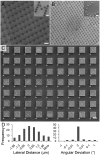Self-assembly of microscopic chiplets at a liquid-liquid-solid interface forming a flexible segmented monocrystalline solar cell
- PMID: 20080682
- PMCID: PMC2824288
- DOI: 10.1073/pnas.0909482107
Self-assembly of microscopic chiplets at a liquid-liquid-solid interface forming a flexible segmented monocrystalline solar cell
Abstract
This paper introduces a method for self-assembling and electrically connecting small (20-60 micrometer) semiconductor chiplets at predetermined locations on flexible substrates with high speed (62500 chips/45 s), accuracy (0.9 micrometer, 0.14 degrees), and yield (> 98%). The process takes place at the triple interface between silicone oil, water, and a penetrating solder-patterned substrate. The assembly is driven by a stepwise reduction of interfacial free energy where chips are first collected and preoriented at an oil-water interface before they assemble on a solder-patterned substrate that is pulled through the interface. Patterned transfer occurs in a progressing linear front as the liquid layers recede. The process eliminates the dependency on gravity and sedimentation of prior methods, thereby extending the minimal chip size to the sub-100 micrometer scale. It provides a new route for the field of printable electronics to enable the integration of microscopic high performance inorganic semiconductors on foreign substrates with the freedom to choose target location, pitch, and integration density. As an example we demonstrate a fault-tolerant segmented flexible monocrystalline silicon solar cell, reducing the amount of Si that is used when compared to conventional rigid cells.
Conflict of interest statement
The authors declare no conflict of interest.
Figures




References
-
- Loo Y-L, Willett R, Baldwin K, Rogers J. Additive, nanoscale patterning of metal films with a stamp and a surface chemistry mediated transfer process: Applications in plastic electronics. Appl Phys Lett. 2002;81:562–564.
-
- Ko HC, et al. A hemispherical electronic eye camera based on compressible silicon optoelectronics. Nature. 2008;454:748–753. - PubMed
-
- Kim D-H, et al. Complementary logic gates and ring oscillators on plastic substrates by use of printed ribbons of single-crystalline silicon. IEEE Electron Device L. 2008;29:73–76.
-
- Yoon J, et al. Ultrathin silicon solar microcells for semitransparent, mechanically flexible and microconcentrator module designs. Nat Mater. 2008;7:907–915. - PubMed
Publication types
MeSH terms
Grants and funding
LinkOut - more resources
Full Text Sources
Other Literature Sources
Research Materials

